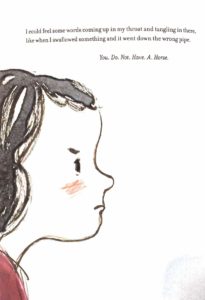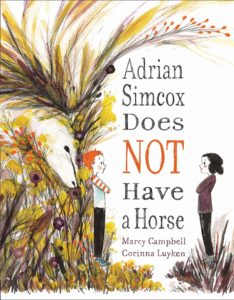Like most books, Amazon told me I would like it! They were absolutely correct. I LOVE it! When I searched for my last book, It Wasn’t Me, this book became a suggestion. At the time I was not sure why, but I am certain it’s because of the book’s message: Everyone has a story.
Why I Finished It:
It is so genuine, moving, and unique! Typically a “don’t bully” book is hardly relatable to kids and the message is awkward. In Adrian Simcox Does NOT Have a Horse, the message isn’t black and white, but it is approachable for young (and old) kids. Adrian Simcox keeps telling people about this horse he has, but Chloe knows he must be lying. He lives in a small house, he’s messy, and doesn’t have a lot of money. It’s driving her crazy that he is lying. By the end of the book, she learns the valuable lesson that everyone has a back story. The beautiful watercolors in this book are mesmerizing and calming, which is such a nice balance to the delicate nature of the text.
Who I Would Give It To:
This is more than likely going to be my first buy for my student teachers. Adrian Simcox Does NOT Have a Horse will be added to my “read the first week of school” pile. It is timely and necessary. As a parent, I read it to my high schoolers! Yes … that’s right … my high schoolers. My kids are beautiful people (I’m biased, but telling the truth), but they sometimes get frustrated with kids who are a little different. It becomes a constant discussion at our dinner table. I always tell them that you have no idea what goes on when other kids leave school or what demons they are fighting on the inside. When I read this book to them, they got it and realized that it isn’t just their crazy mom saying these things. There are a few adults I want to read this to, but can’t figure out how to make that happen yet.
Integration Ideas:
Theme (character feelings) and Text-to-Self Connections (Reading) – Generating Ideas (Writing)

- It’s better to be kind than right
- Everyone has a hidden story
- Find the good in everyone
There are a slew of other statements that are messages from this text! There are also many angles on this storyline, because of varying perspectives. Don’t limit the students to one!
The best lesson here would be to discuss with the students how each character feels throughout the story, stopping at each major section. Stop at the beginning when Adrian is telling everyone about his horse. How does Adrian feel at that point? Chloe? Then stop again when she calls him out in front of everyone. How does Adrian feel? Chloe? The last two stopping points would be when she sees Adrian at home and then at the end. Remember, characters will lead students to the theme or message of a text, but they must understand character first!
The next day, reread the story. Have the students discuss what connections they have, to either character, at any point in the story. Turn and talk. Don’t forget these are ideas they can write about in Writers’ Workshop. All of their text-to-self connections here have the potential to be a powerful narrative for them. I typically have them write them in their writing journals for later.
Ask the students what lessons were learned by the characters. Write the responses on the board. Afterward, read back the responses and ask what message is the author sending? What can be learned by listening to this story? A-HA! We have the theme!
Making Inferences (reading) and Show Don’t Tell (writing)
Truthfully, very little is explicitly stated in this book. Students are going to have to infer throughout to understand the perspective of each character. I always begin with a picture. I would show this picture to the students prior to reading this book on day one. I simply ask, “How is this boy feeling?” We get all our words out and I provide other words for sad. Inevitably one child (just kidding, all of them) will say that he is feeling sad. And I respond, “He does look sad. Is he depressed, lonely, or sorry? Which kind of sad is he?” This provides the students with three other words to work with and explain. Because when a child responds that he is lonely, I ask why? They will provide an answer that connects with their schema, but another kid will respond with, “he’s not lonely, he has a dog.” I never say yes or no to anything, but respond with, “That’s a great point. He does have a dog. Is it possible to still feel lonely and have a dog?” The idea is to keep the discussion going and provide fun *sparkle* words for the students to practice using.
Once they have made inferences about the picture by inferring how the boy is feeling and why we will move into this text. Throughout this story, students should be making inferences about how both Adrian and Chloe feel (see above). They also can be making inferences as to why Adrian is making up the idea of having a horse.
 Since the students are having to make inferences about how the characters feel, the author has used “Show Don’t Tell” in their writing. Use this as a mentor text for their own writing. Take the page to the left. Read it to the students and ask how Chloe is feeling, ask how they know, and what this makes them think about (connect to their schema). Point out that the author never TOLD the reader how she felt, we had to take her words and actions and infer how she felt. The author SHOWED us. Have the students try in their own writing. Have them choose a person in their writing. Ask how the person is feeling at that moment. Then have the students think about what the character would say or do that would SHOW the reader how they felt.
Since the students are having to make inferences about how the characters feel, the author has used “Show Don’t Tell” in their writing. Use this as a mentor text for their own writing. Take the page to the left. Read it to the students and ask how Chloe is feeling, ask how they know, and what this makes them think about (connect to their schema). Point out that the author never TOLD the reader how she felt, we had to take her words and actions and infer how she felt. The author SHOWED us. Have the students try in their own writing. Have them choose a person in their writing. Ask how the person is feeling at that moment. Then have the students think about what the character would say or do that would SHOW the reader how they felt.
Websites and Text-to-Text Connections
As I said, this book easily lends itself to making connections with other texts we have reviewed:
- It Wasn’t Me. This picture book could be an excellent anticipatory set for the novel. I would read this picture book first and get the students thinking about backstories before digging into It Wasn’t Me.
- Pig the Pug. This is a fun story about friendship and kindness. On our post, we also talk about other picture books that connect.
- Classroom Rules List. I am going to add this book to my book about creating classroom rules. It adds to my classroom theme of Be Kind.
- Refugee. This would be a great anticipatory set for Refugee as well. There is the idea of everyone has a story, take some time and get to know someone.
Don’t forget to visit the author’s website: http://marcycampbell.com/
One last thought – set up a Random Acts of Kindness monthly calendar in your classroom. Here’s an example that could be tweaked for your classroom: https://wondermomwannabe.com/february-acts-of-kindness-calendar/
Please let us know your thoughts on this book! (Because sharing is kind) ?







Leave a Reply